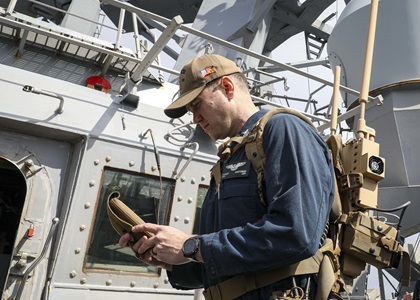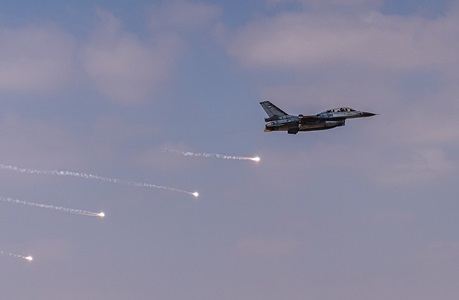Electronic Warfare

Modern battles begin invisibly.
The military uses the electromagnetic spectrum — essential, yet invisible — to detect, deceive and disrupt the enemy while protecting friendly forces. As enemies become more capable and threats more complex, controlling the spectrum is increasingly critical.
Staying ahead in this era calls for a new generation of capabilities. Northrop Grumman’s expertise in electronic warfare, cyber and electromagnetic maneuver warfare spans all domains – land, sea, air, space, cyberspace and the electromagnetic spectrum. Northrop Grumman’s multispectral, multifunction systems give warfighters superiority across the spectrum and allow for faster, more informed decisions.
Spectrum Superiority Starts Here
Before the mission, before production and fielding, there is production and test. Modern electronic warfare systems are highly complex, requiring equally sophisticated environments that can replicate threat environments accurately. Northrop Grumman’s Combat Electromagnetic Environment Simulator (CEESIM) family of systems faithfully simulates true-to-war conditions. Simulations of this quality offer the most cost-effective means of testing and validating the effectiveness of sophisticated EW equipment.
Airborne Electronic Warfare
Naval Airborne Electronic Warfare
Northrop Grumman has provided Naval Airborne Electronic Warfare solutions for more than 55 years and is the Airborne Electronic Attack System Integrator for the U.S. Navy warfighter.
In the air, Northrop Grumman electronic warfare systems help ensure that strike aircraft can reach their targets and return home safely. As survivability and targeting converge in the electromagnetic spectrum, Northrop Grumman’s technologies are addressing the advanced electronic warfare threats. Situational awareness is critical to air dominance and our airborne electronic warfare systems allow warfighters to disrupt, deceive and deny a broad range of electronic systems.

Northrop Grumman continues to be the leader in design, development and delivery of end-to-end electronic maneuver warfare solutions to the U.S. Navy. From building, maintaining and upgrading electronic sensing systems for the Northrop Grumman EA-6B Prowler and Boeing EA-18G Growler electronic combat aircraft, to producing radar warning receivers and electronic support measures for other platforms like the Boeing P-8A Poseidon – Northrop Grumman is leading the way.
Self-Protection: Infrared and Radio Frequency
Aviators face both infrared and radio frequency threats, so Northrop Grumman is developing self-protection capabilities across the spectrum.
Northrop Grumman’s open systems EW architecture offers the bandwidth needed to detect and defeat the most sophisticated RF threats, including agile air defense systems. Shared across the company’s family of EW systems, which includes capabilities for fighters, airlifters and rotary wing aircraft, this pioneering technology can protect virtually any platform or mission. For the U.S. F-16 fleet, the AN/ALQ-257 Integrated Viper Electronic Warfare Suite (IVEWS) provides full-spectrum radar warning, threat identification and advanced countermeasure capabilities. It has proven pulse-to-pulse operability with the F-16’s AN/APG-83 Scalable Agile Beam Radar (SABR), also built by Northrop Grumman. The electronic warfare suite configuration is scalable to meet both U.S. and international partners’ operational needs in either an internal or podded configuration.

In addition, Northrop Grumman is providing the ALQ-251 radio frequency countermeasures system for the Special Operations Command AC/MC-130J tactical airlifters. The operators of these large aircraft will benefit from the ability to maneuver safely in highly contested spectrum environments.
For rotary wing aircraft, the AN/APR-39 Radar Warning Receiver/Electronic Warfare Management System maximizes survivability by improving aircrew situational awareness via interactive management of all onboard sensors and countermeasures.

Northrop Grumman is the leader in providing optical laser-based systems that detect infrared threats and protect aircraft – large and small fixed-wing, rotary-wing, and tilt-wing platforms – from advanced missile threats. These self-protect family of programs include Directional Infrared Countermeasure (DIRCM), Common Infrared Countermeasure Systems (CIRCM) and LAIRCM G3.
Advanced Anti-Radiation Guided Missile
AGM-88E provides the U.S. Navy, U.S. Marine Corps and Italian Air Force the latest and most advanced weapon system for engaging and destroying enemy air defenses and time-critical, mobile targets. AARGM is a supersonic, medium-range, air-launched tactical missile compatible with U.S. and allied strike aircraft, including all variants of the F/A-18, Tornado, EA-18G, F-16, EA-6B, and F-35 (external).
Naval Electronic Warfare
Northrop Grumman is helping to write an exciting new chapter in maritime EW. Drawing on a rich heritage in the design and development of EW systems and solutions stretching back 60 years – including names such as Northrop, Hallicrafters, Grumman, Litton Amecom, TRW and Westinghouse – the company is today pushing the technological boundaries to bring a new set of advanced capabilities to the warfighter. This pedigree in maritime EW is founded on a wealth of innovative research, science and technology at the leading edge of electromagnetics, advanced engineering and end-to-end systems integration experience across all subdivisions of EW.
As EW continues to shape the future battlespace, Northrop Grumman is advancing a critical capability for the U.S. Navy. The Surface Electronic Warfare Improvement Program (SEWIP) protects surface ships from anti-ship missiles, providing early detection, signal analysis and threat warning. SEWIP Block 3, being developed by Northrop Grumman and the U.S. Navy Program Executive Office Integrated Warfare Systems (PEO IWS), adds electronic attack to the SLQ-32(V) EW system, and is a cornerstone capability that will meet the urgent operational needs of the Fleet.
Maritime Information Warfare
Information warfare (IW) is a strategy for the use and management of information to pursue a competitive advantage, including both offensive and defensive operations. Getting actionable information to the warfighter in tactically-relevant time is critical to mission success. Today, in the maritime domain, critical data is collected and then analyzed later at a shore-based facility. This information is often stove-piped and difficult to access by Sailors who are fulfilling the mission while in harm’s way.

Digital Transformation
As the Navy progresses toward digital data transformation to outpace emerging threats, achieving a decisive advantage will require common, open and interchangeable data formats in order to accelerate the sharing of target information. In a battlespace where data is a commodity, this commonality will be the key to unite all platforms, sensors and weapons systems creating a single environment to execute distributed and fully integrated maritime operations.
The United States is continuously engaged in Information Warfare to ensure full access and control of the EMS. A seamlessly connected maritime environment will require a thoroughly networked and digitized Navy. Twenty-first century warfare superiority is dependent on unrestrained awareness that must be achieved by establishing dominance across the EMS, including the tactical advantage of conducting effective Real Time Spectrum Operations (RTSO). Turning data into superior, actionable information at machine speed is a clear discriminator in the warfighter’s decision-making process.
Achieving Greater Offensive Capability
With the offensive capability of the Surface Electronic Warfare Improvement Program (SEWIP) Block 3, the full force of Northrop Grumman’s maritime electronic and information warfare suite will be used to detect, deny, deceive and defeat threats. Through greater use of non-kinetic solutions such as advanced electronic jamming, cyber operations and directed energy, a greater number of shipboard missiles may be used for power projection rather than self-defense, resulting in both greater offensive and improved defensive capacity for optimum warfighting capability.
Multi-Domain Information Warfare
The Northrop Grumman Counter Communications solutions address the detect, identify, track, and defeat aspects of the non-kinetic unmanned weapon systems kill chain. Multi-function, software defined, and fully configurable, each system can be optimized for each mission need. These products are built from Northrop Grumman subject matter expertise acquired from many years building small form factor, highly capable software defined radios for F-22 and the F-35. Our technology, similar to a commercial cell phone, maintains common hardware while applications are added and used based on operator need. By using common architectures, software, hardware, and techniques are shared without requiring unique development costs or timelines. “Pay once, then reuse.” Counter communications degrade and deny enemy networks such as adversary Command and Control (C2), Telemetry, radio controlled improvised explosive devices, and small Unmanned Aircraft Systems (sUAS). As the concept of operations evolve, these systems provide the flexibility to support the driving needs.
Counter-sUAS
The Counter Communications solutions detect threats by scanning the environment for potential radio frequency and identifying signals of interest through field-configurable parameters. Intelligent algorithms determine if the signal is a known threat. If confirmed, an audio and visual alarm alerts the operator. The system can be configured to respond automatically or require operator input to initiate a denial. If the system is operating in a passive mode, an operator will positively identify the threat following a detection using the multi-sensor target verification capability. Identification and tracking capabilities provide the warfighter options to interrogate the sUAS threat and determine intent before executing a defeat solution.

Protecting Land Forces
Northrop Grumman is also applying advanced EW technologies to build next-generation systems for protecting troops on the ground from device-triggered IEDs. As the prime contractor for JCREW – the Joint Counter Radio-Controlled Improvised Explosive Device (RCIED) Electronic Warfare (JCREW) Increment 1 Block 1 – the company is providing software-programmable jammers that protect warfighters in vehicles, on patrol or in forward operating bases from RCIEDs.
JCREW systems establish a protective barrier from enemy threats while allowing blue force communications to continue. The spectrally aware, always on, counter-communications system provides 360 degrees of protection regardless of the number of threats present or inputs from external warfighters or electronic sensors threat detections.

Cyberspace
Cyberspace, now recognized as a warfighting domain, represents an important new warfighting frontier. Cyberspace and the electromagnetic spectrum (EMS) have converged with the use of wireless capabilities for IP-based networking. For example, instead of a kinetic effect or direct electronic attack (EA) against a hostile emitter, could we insert a cyber technique into a wireless network connected to the emitter that provides an avenue to achieve the same effect as a direct EA?
With the growing militarization of cyberspace, we must be careful that if we enable offensive capabilities we will also need to have defense capabilities as well similar to electronic protection. Within Cyberspace, there are three subdivisions similar to EW that include Defensive Cyberspace Operations, Offensive Cyberspace Operations and protection of critical network infrastructure.
From a defensive perspective, systems today may not be able to operate effectively if they are not designed with cyberspace protection. In other words, systems must be designed to be safe or “resilient” from malicious cyberspace operations. This is referred to as Cyber Resilience. Northrop Grumman delivers trusted Cyber and intelligence services to its customers, including analysis, research, architecture design, maintenance, modification and in-service monitoring, integrated logistics support in Cyberspace operations, security accreditation and assessment. The company offers a full spectrum of cyber capabilities with built-in resilience to provide assured protection against evolving threats in the cyberspace domain.
Vision for the Future
As enemies become more capable and threats more complex, Northrop Grumman is designing and building smarter, more agile systems and providing multi-function, affordable solutions to give our forces an overwhelming advantage across the spectrum.
Designing Future-Friendly Systems
Sustainment costs for legacy, single-function systems can strain budgets. Obsolescence is an inevitable and sometimes costly concern.
Digital architecture has changed the equation. Electronic warfare suites can now perform multiple functions and support diverse mission sets, and components and software can be shared among a family of systems. Under this building block approach, in use now at Northrop Grumman, development costs and timelines decrease, upgrade cycles are faster and economies of scale kick in during production. As new threats are identified, enhancements can be shared quickly throughout the product line. Often, only a software change is required to add new capabilities, minimizing the obsolescence risk and decreasing the time to field.
In the News

Northrop Grumman’s Mission Solutions Aim To Keep Fourth-Generation Aircraft Lethal And Survivable (The War Zone Wire)





F-16 electronic self-protection system completes government lab integration (DefenseScoop)

Northrop Grumman-built Common Infrared Countermeasure Systems Approved by US Army for Early Fielding


Advancing Survivability for Army Aircrews – A Generational Leap in Threat Detection Technology
Contact Us
AARGM
Jarrod Krull
(763) 248-2686
Electromagnetic Maneuver Warfare
Fernando Catta-Preta
(434) 974-2736
Chad Tragakis
(443) 534-2835
Electronic Attack
Brittany King
(434) 996-6579
Electronic Countermeasures / Infrared Countermeasures
Ellen Hamilton
(224) 625-4693
Stephen Lamb
(224) 625-4627
The appearance of U.S. Department of Defense (DoD) visual information does not imply or constitute DoD endorsement.


